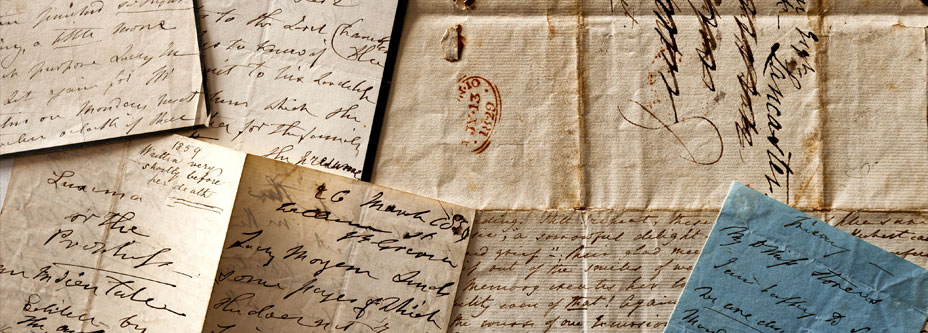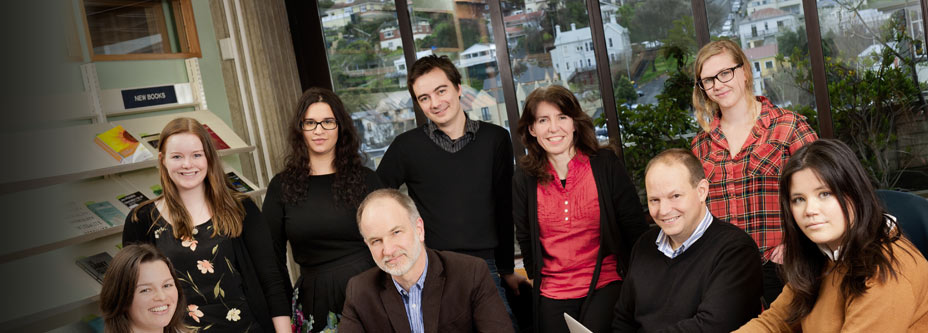
"In Her Hand"
Previously unpublished letters of 18th and 19th century women writers – many of which were surprisingly found in the Dunedin Public Library – have provided the inspiration for a book published by a group of English honours students.

The class of ENGL 404 and authors of In Her Hand.
Changing tastes, or perhaps the forces of pride and prejudice, caused the work of many 18th- and 19th-century women writers to fade into obscurity. But a recent student publication based on the correspondence of 11 such writers sheds new light on their literary careers and personal lives.
In Her Hand: Letters of Romantic-Era British Women Writers in New Zealand Collections was produced in just 14 weeks by honours students enrolled in ENGL404: Writing for Publication. The students based their research on previously unpublished letters and manuscripts in New Zealand library collections.
Course co-ordinators Dr Tom McLean and Dr Shef Rogers say that, although the women writers discussed are now less familiar, many were once household names.
“There will be some excitement to see these letters published because the authors have all been the subject of recent scholarly research. What is very special is that our students are the first to comment on these letters and, in future, they will be the first ones cited in relation to this material,” McLean says.
Most of the letters in In Her Hand come from the Dunedin Public Library's Alfred and Isabel Reed Special Collection. From the 1920s, Reed – best known in New Zealand as a prolific author and publisher – bought miscellaneous collections of letters from London dealers. His collection was presented to the Dunedin Public Library in 1948.
“It really is by chance that these letters are here. There are researchers worldwide studying these writers who would never think to look for source material in New Zealand. The students could only have had this opportunity here at Otago, because if the letters were in Britain or the United States many of them would have already been published,” McLean says.
The correspondence provides glimpses into the women's lives: social and political issues are discussed alongside personal concerns such as health, friendship, family and marriage, and the processes of writing.
Student Petra Westropp says the letters also touch on gender difference, which was increasingly relevant in an age that saw the emergence of writers such as Mary Wollstonecraft who questioned gender inequality and an idealised construction of femininity.
As McLean points out, few female authors of the Romantic era published under their own name. While there were notable exceptions, such as historian Lucy Aikin and poet Felicia Hemans (whose sales were second only to those of Lord Byron), many others – including Jane Austen – did not disclose their identity.
During the semester, students were immersed in the collaborative project. All publication details, including layout, design and final proofs, were developed as a collective.
Westropp describes the process of producing the book, while simultaneously writing and developing several draft versions of her own chapter, as one of the most intense but rewarding experiences of her time at Otago.
“It is hard to gain work experience while studying, so this paper was invaluable. To be able to say that I was published at 21 is fantastic and the end product is something tangible I can use to boost applications for future study, specifically publishing courses.”
Fellow student Samantha McKegg also describes learning about book production as “invaluable”.
“We spent hours thinking about the book's look and feel, and its potential uses. There were sleepless nights and occasionally tensions arose, but this showed how much we really cared about the project. It was all worthwhile because the finished product is one to be proud of.”
McKegg, who discussed writer Anna Jameson's emergence as one of the first female art historians, said the “devil was in the detail” when making observations about the women's lives.
“The excitement of scrutinising letters that were 200 years old never faded. My favourite letters were the notes to friends or relatives, and we all found that even seemingly inconsequential letters could show something interesting or significant about the authors' lives and work.”
This attention to detail drew praise from external examiner Professor Devoney Looser of Arizona State University, who commended the publication as “a book of exceptional quality and scholarly importance” that presents the larger context “while providing readers with the ability to understand the minutiae of each of the letters”.
Professor Looser is not alone in her admiration. In Her Hand has already been acquired by research libraries in New Zealand, Australia and the United States.
In Her Hand can be purchased from the Department of English.
SAM STEVENS